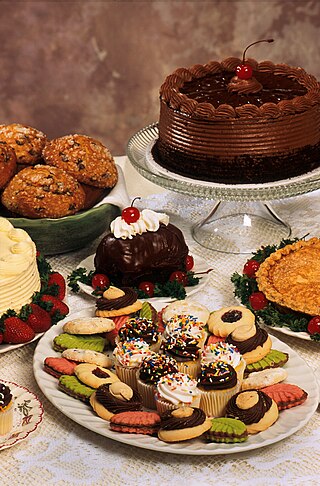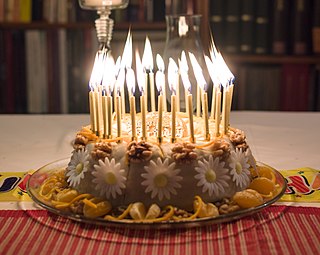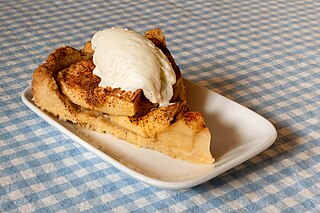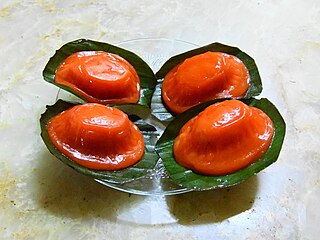
Dessert is a course that concludes a meal. The course consists of sweet foods, such as cake, biscuit, ice cream and possibly a beverage such as dessert wine and liqueur. Some cultures sweeten foods that are more commonly savory to create desserts. In some parts of the world there is no tradition of a dessert course to conclude a meal.

Cake is a flour confection made from flour, sugar, and other ingredients and is usually baked. In their oldest forms, cakes were modifications of bread, but cakes now cover a wide range of preparations that can be simple or elaborate and which share features with desserts such as pastries, meringues, custards, and pies.

A lamington is an Australian cake made from squares of butter cake or sponge cake coated in an outer layer of chocolate sauce and rolled in desiccated coconut. The thin mixture is absorbed into the outside of the sponge cake and left to set, giving the cake a distinctive texture. A common variation has a layer of cream or strawberry jam between two lamington halves.

A doughnut or donut is a type of pastry made from leavened fried dough. It is popular in many countries and is prepared in various forms as a sweet snack that can be homemade or purchased in bakeries, supermarkets, food stalls, and franchised specialty vendors. Doughnut is the traditional spelling, while donut is the simplified version; the terms are used interchangeably.

A birthday cake is a cake eaten as part of a birthday celebration. While there is no standard for birthday cakes, they are typically highly decorated layer cakes covered in frosting, often featuring birthday wishes and the celebrant's name. In many cultures, it is also customary to serve the birthday cake with small lit candles on top, especially in the case of a child's birthday. Variations include cupcakes, cake pops, pastries, and tarts.

A king cake, also known as a three kings cake, is a cake associated in many countries with Epiphany. Its form and ingredients are variable, but in most cases a fève such as a figurine, often said to represent the Christ Child, is hidden inside. After the cake is cut, whoever gets the fève wins a prize. Modern fèves can be made of other materials, and can represent various objects and people.

Austrian cuisine is a style of cuisine native to Austria and composed of influences from Central Europe and throughout the former Austro-Hungarian Empire. Austrian cuisine is most often associated with Viennese cuisine, but there are significant regional variations.

A cinnamon roll is a sweet roll commonly served in Northern Europe and North America. In Sweden it is called kanelbulle, in Denmark it is known as kanelsnegl, in Norway it is known as kanelbolle, skillingsbolle, kanelsnurr, or kanel i svingene, in Finland it is known as korvapuusti, in Iceland it is known as kanilsnúður, and in Estonia it is known as kaneelirull. In Austria and Germany, it is called Zimtschnecke.

Kringle is a Northern European pastry, a variety of pretzel. Pretzels were introduced by Roman Catholic monks in the 13th century in Denmark, and from there they spread throughout Scandinavia and evolved into several kinds of sweet, salty or filled pastries, all in the shape of kringle.

Æbleskiver are spherical Danish snacks made from fried batter. The name literally means "apple slices" in Danish, although apples are not usually an ingredient in present-day versions. The crust is similar in texture to European pancakes, but with a light and fluffy interior similar to a Yorkshire pudding. The English language spelling is usually aebleskiver,ebleskiver or ebelskiver.

Apple cakes are cakes in which apples feature as a main flavour and ingredient. Such cakes incorporate apples in a variety of forms, including diced, pureed, or stewed, and can include common additions like raisins, nuts, and 'sweet' spices such as cinnamon or nutmeg. They are a common and popular dessert worldwide, thanks to millennia of apple cultivation in Asia and Europe, and their widespread introduction and propagation throughout the Americas during the Columbian Exchange and colonisation. As a result, apple desserts, including cakes, have a huge number of variations.

A bear claw is a sweet, yeast-raised pastry, a type of Danish, originating in the United States during the mid-1910s. In Denmark, a bear claw is referred to as a kam. France also has an alternate version of that pastry: patte d'ours, created in 1982 in the Alps. The name bear claw as used for a pastry is first attested in March 1914 by the Geibel German Bakery, located at 915 K Street in downtown Sacramento. The phrase is more common in Western American English, and is included in the U.S. Regional Dialect Survey Results, Question #87, "Do you use the term 'bear claw' for a kind of pastry?"

Kransekage (Danish) or kransekake (Norwegian) is a traditional Danish and Norwegian confection, often eaten on special occasions in Scandinavia. In English, the name means wreath cake. In Norway it is alternatively referred to as tårnkake and often prepared for Constitution Day celebrations, Christmas, weddings, and baptisms. In Denmark it is typically eaten as part of New Year celebrations, while a variation of the cake, overflødighedshorn, is traditionally served at weddings and baptisms.

Streuselkuchen, also known in English-speaking countries as crumb cake, is a cake made of yeast dough covered with a sweet crumb topping referred to as streusel. The main ingredients for the crumbs are sugar, butter, and flour, which are mixed at a 1:1:2 ratio. The recipe allegedly originated in the region of Silesia, and is popular in German, Polish and Ashkenazi Jewish cuisines.

A birthday is the anniversary of the birth of a person, or figuratively of an institution. Birthdays of people are celebrated in numerous cultures, often with birthday gifts, birthday cards, a birthday party, or a rite of passage.

Ang ku kueh, also known as red tortoise cake, is a small round or oval-shaped Chinese pastry with soft, sticky glutinous rice flour skin wrapped around a sweet central filling. It is molded to resemble a tortoise shell and is presented resting on a square piece of banana leaf. As suggested by its name, red tortoise cakes are traditionally red in color and has a sticky, chewy texture when eaten. Red tortoise cakes are shaped like tortoise shells because the Chinese traditionally believed that eating tortoises would bring longevity to those who are eating it and bring about good fortune and prosperity. Considered to be auspicious items, these sweet pastries are especially prepared during important festivals such as Chinese New Year as offerings to the Chinese deities.

A spit cake is a European-styled cake made with layers of dough or batter deposited, one at a time, onto a tapered cylindrical rotating spit. The dough is baked by an open fire or a special oven, rotisserie-style. Generally, spit cakes are associated with celebrations such as weddings and Christmas. The spit can be dipped in a thin dough, or the dough can be poured or rolled on the spit.

The ninth series of The Great British Bake Off began on 28 August 2018, with this being the second series to be broadcast on Channel 4. The series is presented by Noel Fielding and Sandi Toksvig, with judges Paul Hollywood and Prue Leith. This series saw a few changes to the usual format: the first episode being Biscuit Week, the documentary inserts were dropped, and the finale included the competitors doing a technical challenge outside the tent for the first time.


















